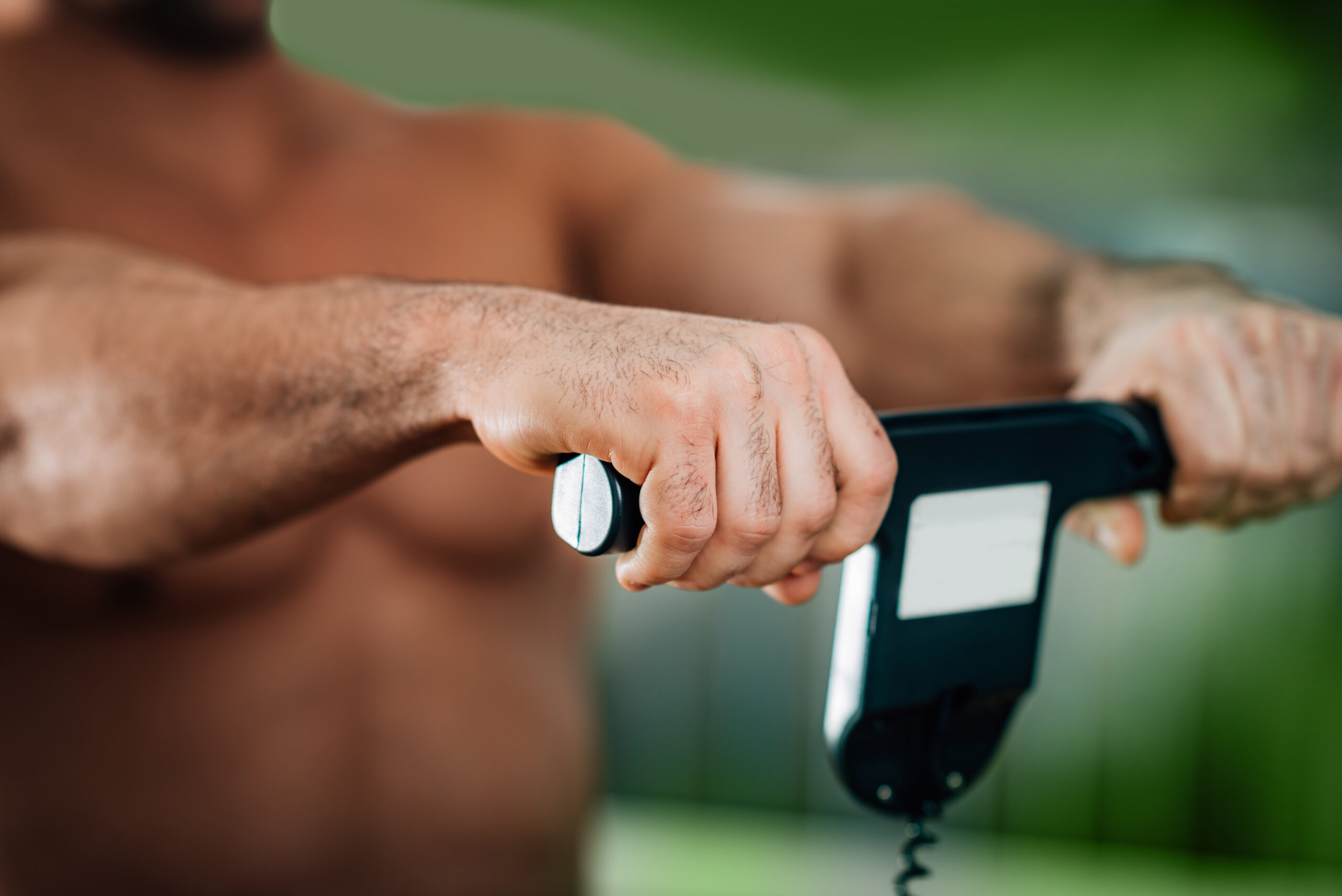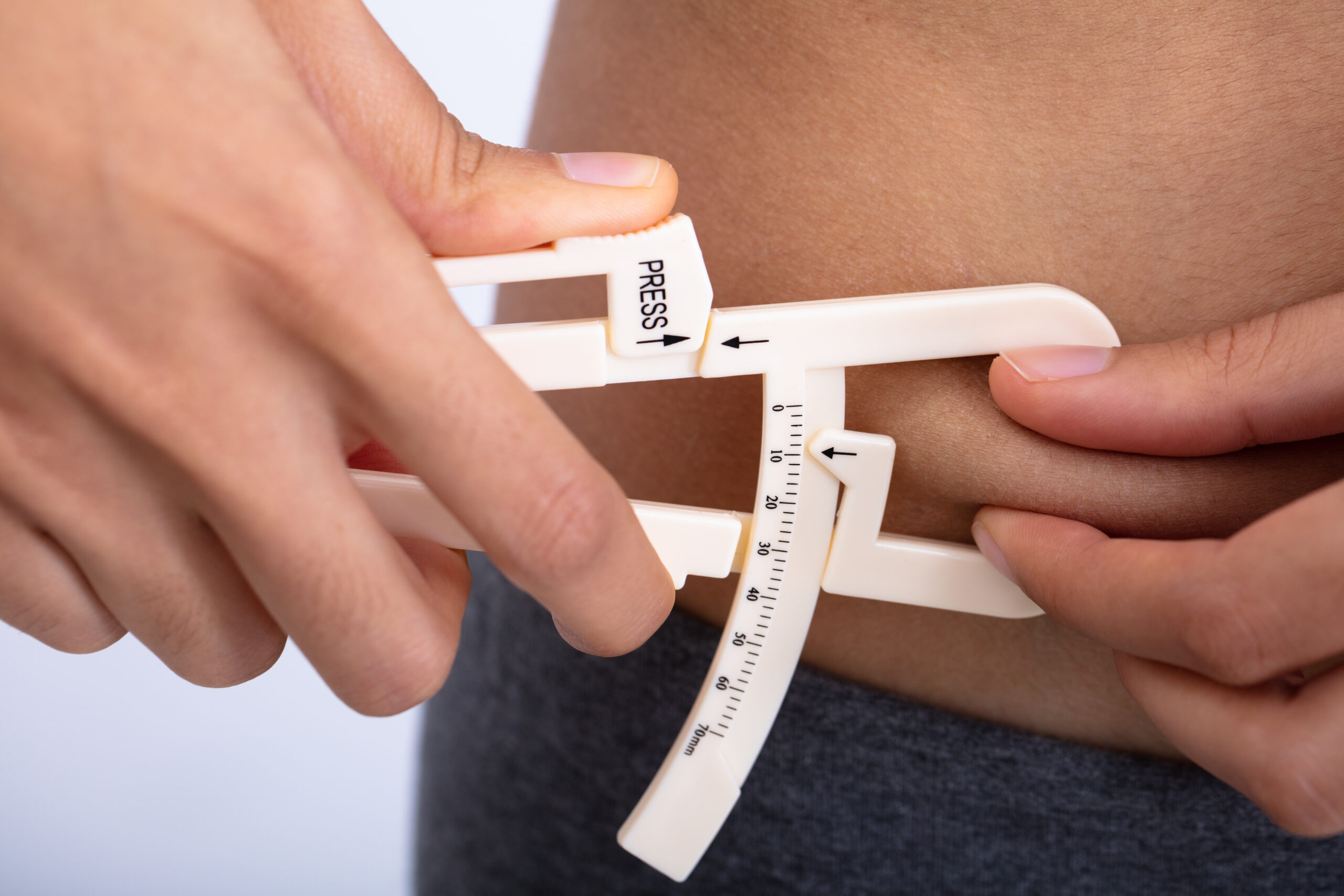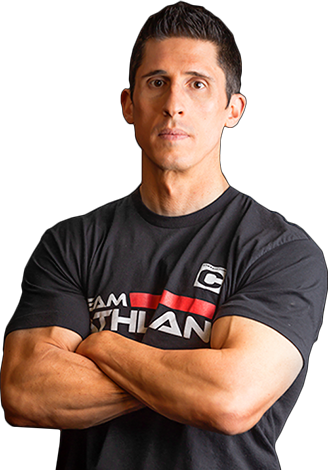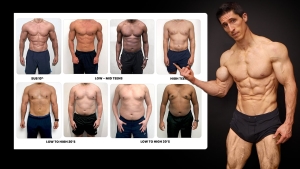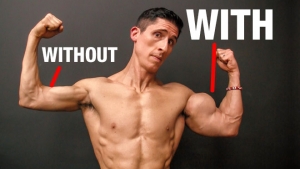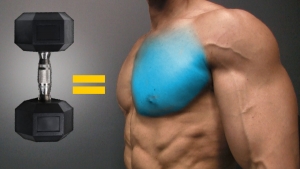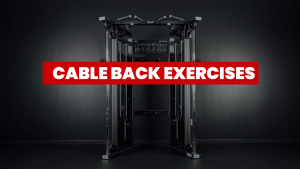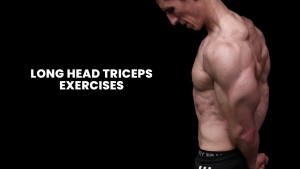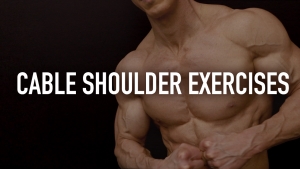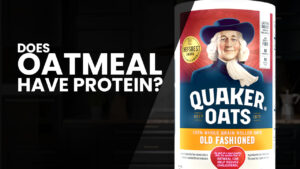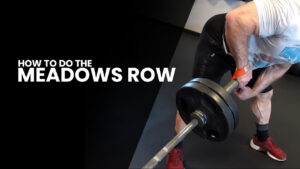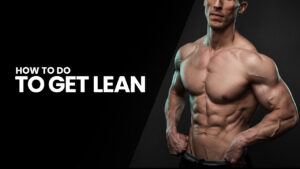The two Body Fat Calculators below will give you an estimate of your body fat based on two separate types of measurements. You can do the tape measurement method if you have a flexible tape or use string to take your circumference measurements and measure the string with a rigid tape measurer or a ruler. If you have access to a skin fold caliper, you can try the skinfold method. Alternatively you can try both methods to get an even better idea of your actual body fat level.
SKIN FOLD METHOD
TAPE MEASURE METHOD
HOW TO MEASURE BODY FAT AT HOME
The number on the scale doesn’t tell you much. Two people can weigh the same but have completely different levels of body fat, lean muscle, and health risk factors.
That’s why tracking body composition matters more than tracking body weight.
This page features two accurate methods to calculate your percentage of body fat.
First, you’ll find a tape measurement-based body fat calculator using body measurements like waist circumference at the belly button.
Second, there’s a skinfold method using skinfold calipers to measure fatty tissue at key sites.
Most body fat scales that use bioelectrical impedance analysis or 3D body scanning technology are affected by body water content, hydration, and other variables. Not to mention, these methods can be pricey and inconvenient.
For those serious about accuracy and convenience, tools like precision calipers, tape, and consistent calculation methods provide more reliable results.
Knowing your body fat percentage helps you track progress, adjust calorie intake, and balance strength training, cardiovascular exercises, and a healthy diet to lower excess body fat while maintaining muscle.
Use these calculators to estimate your actual body composition and set clear health goals based on your current body fat level and your desired target body fat.
WHAT IS BODY FAT?
Body fat is often treated like the enemy. But in reality, it’s a critical part of the human body, not just for appearance, but for survival, performance, and health.
You need a certain amount of essential body fat to function properly.
This fat helps produce essential hormones, maintain body temperature, cushion organs, and serve as an energy source during daily activity.
Without it, the production of hormones, recovery, and your metabolic rate can tank. For both men and women, there’s a minimum allowable percent body fat needed just to stay alive.
Fat stored beyond this minimum is known as storage body fat, which accumulates in adipose tissue.
This fat layer acts as fuel when you’re in a calorie deficit or doing physical activity like cardio exercises, moderate exercises, or High-Intensity Interval Training.
But too much internal body fat or excess body fat mass becomes a liability.
It increases risk factors like cardiovascular disease, factors for heart disease, and even congenital disease in children with health problems.
In short, fat has a function, but the key is balance.
FAT RANGES AND HEALTH
There is no one-size-fits-all fat percentage range. The ideal body fat percentage depends on multiple factors: age, sex, training experience, tissue structure, even genetics.
Fat percentages also vary from person to person, especially between a sedentary person and a muscular person with high bone density and more lean mass.
Here’s a general breakdown of the average range of values used by fitness experts, health professionals, and even in the Army Body Fat Assessment:
Men: 10–20% body fat is considered a healthy range
Women: 18–28% is the standard range for women
These numbers represent a balance of performance, aesthetics, and health. Athletes and trained individuals tend to fall near the lower end, while sedentary individuals often fall outside these boundaries.
Typical body fat standards use a defined body fat requirement based on waist measurements, body circumference measures, and calculated weight range.
HOW TO CALCULATE BODY FAT
Body fat is more than something you “burn off.” It’s a body store for energy, a buffer against starvation, and a reserve to keep the body functioning under stress.
But once fat tissue moves beyond its functional range, it becomes a threat to performance and long-term health.
Understanding your body mass, not just your weight measurement, gives a clearer measure of health.
A 200-pound athlete with 12% body fat has a completely different tissue density and fat layer compared to someone at the same weight with 30% body fat.
This is why fat calculators, whether using the body fat formula, calorie calculator, or body fat calculation formula, focus on estimating the percent of body fat, not just weight in pounds.
While there are many alternative methods for the assessment of body fat, including Underwater Weighing (Hydrostatic Weighing), Air-Displacement Plethysmography, Dual-Energy X-ray Absorptiometry (DEXA), and bioelectrical impedance analysis (BIA), these are often used as supplemental body fat assessments due to cost, access, and error rates.
Some rely on electrical currents, others on tissue density or bone density, but all aim to improve accuracy beyond a basic body fat tape test or scale.
Knowing your body fat percentage is the first step to building a smart plan. It helps you figure out how much body fat to lose, how much lean muscle you’re carrying, and what’s realistic for your goals.
There are two common methods that don’t require a lab or $200 scan.
Both can help you estimate fat percentage ranges and track your progress over time, especially if your goal is long-term loss of body fat, not just dropping weight.
TAPE MEASUREMENT METHOD
This method uses a circumference-based tape method to calculate body fat based on body circumference at key areas.
Using a soft measuring tape, this method factors in your waist (at belly button level), neck, and hips (for women).
These values, along with height, plug into a body fat formula to estimate the calculation of body fat and lean mass.
It’s based on the idea that fat tends to collect in predictable areas across the average body. Larger body fat measurements around these sites usually indicate higher adipose tissue layer storage.
Pros
- Fast and cheap
- Requires no special equipment
- Great for tracking changes over time
Cons
- Built around population averages and doesn’t account for unique behavioral factors or body types
- Less reliable for very lean or highly muscular individuals
- Estimates your fat to the nearest pound
Still, when done consistently, this assessment method works well for people doing basic exercise, regular exercise, or substantial training, especially when paired with a solid combination of diet and calorie deficit for fat for energy conversion.
SKINFOLD CALIPER METHOD
The skinfold method involves using calipers to pinch and measure the thickness of a fat layer just beneath the skin at specific sites.
These values are then used to calculate your body fat percentage using a calculation of body density and established equations.
There are two types of site testing:
Three-Site Method:
The three-site method is the most commonly used skinfold testing protocol for general fitness assessments.
For men, the measurement sites typically include the chest, abdomen, and thigh.
For women, the three sites are usually the triceps, suprailiac (just above the hip on the side of the waist), and thigh.
These locations are chosen because they represent common areas of fat storage across the population.
Seven-Site Method:
The seven-site method includes all the three-site locations and adds four more: the midaxilla (side of the chest), subscapular (beneath the shoulder blade), triceps, and abdomen, for a total of seven points.
This expanded test improves accuracy by offering a more comprehensive estimate of how much fat is stored in the adipose tissue layers across multiple regions of the body.
Both methods help establish a clearer picture of your fat range and where you fall within different weight ranges and body fat categories.
TIPS FOR ACCURACY WHEN MEASURING BODY FAT
Getting a precise body fat measurement doesn’t require a lab, but it does require consistency.
Small errors in technique, whether you’re using a tape or calipers, can throw off your results and mislead your progress tracking.
Here’s how to tighten up your method, no matter which one you choose.
TAPE MEASUREMENT METHOD
For the tape measure method, make sure the tape is flat against the skin, no twisting or pinching.
Pull the tape snug, but not tight enough to compress the skin or underlying adipose tissue layer. Take measurements at the same anatomical points each time.
For example, for waist measurements, always measure at the belly button level, not slightly above or below. Wear the same type of clothing or, better yet, measure directly on skin.
Stand upright but relaxed, not sucking in or pushing out the stomach, and exhale before taking the measurement.
Repeat each measurement at least twice and take the average to reduce human error.
For the most consistent results, measure under the same conditions: same time of day, same hydration level, and ideally before physical activity.
SKINFOLD CALIPER METHOD
For the skinfold caliper method, consistency is even more critical. Always measure the same side of the body, typically the right side, and use the same tester every time.
A small change in pinch technique or placement can affect the reading.
Be sure to grasp only the fat layer, not muscle, and place the caliper jaws about one centimeter below the fingers, perpendicular to the skinfold.
Avoid measuring after workouts or heavy meals, as blood flow and calories for energy can temporarily shift body stores and distort results.
For best accuracy, take all readings in a fasted or rested state, ideally at the same time of day, and repeat each site at least twice, averaging the closest two readings.
If you’re new to calipers, consider practicing or getting help from a trained professional until your technique becomes second nature.
Regardless of the assessment method you choose, remember this: the choice of method should stay consistent across weeks or months.
Switching between different calculators for body fat, devices, or formulas makes it harder to trust your trend line, even if your fat percentage appears to change.
Stick with one system, refine your technique, and track over time. That’s how you turn a rough estimate into a reliable tool for fat loss, muscle gain, or meeting your body fat requirements.
HOW TO USE THE SKINFOLD BODY FAT CALCULATOR
If you’re serious about tracking real fat loss, this is where you start. Forget guessing. Forget the scale.
This calculator uses the Jackson-Pollock 3-site skinfold method, one of the most reliable field tools out there, if you do it right.
Here’s how to make sure you don’t mess it up:
STEP 1: CHOOSE YOUR GENDER
This matters. Men and women store fat differently, and the calculator adjusts for that.
- Select Male or Female from the dropdown.
STEP 2: ENTER YOUR WEIGHT AND AGE
You don’t need your life story here. Just enter the basics:
- Weight: Enter your current body weight in pounds
- Age: Type in your age in years
The calculator uses this to help estimate your fat mass and lean mass, so focus on being accurate to get the best results.
STEP 3: MEASURE YOUR SKINFOLDS
This is where most people screw up.
Use skinfold calipers and measure the fat layer just under the skin at three specific sites. Follow these depending on your gender:
For Men:
- Chest: Diagonal pinch halfway between armpit and nipple
- Abdomen: Vertical pinch about one inch to the right of your belly button
- Thigh: Vertical pinch halfway down the front of your thigh
For Women:
- Triceps: Vertical pinch halfway between shoulder and elbow on the back of the arm
- Suprailiac: Diagonal pinch just above the hip bone, near the waistline
- Thigh: Same as above (vertical pinch on the front of the thigh)
Measure each site twice, then take the average for each and enter it into the Skinfold 1, 2, and 3 boxes in millimeters (mm).
Do all your measurements on the right side of the body, fasted or at least two to three hours after a meal, and before working out.
STEP 4: HIT “CALCULATE BODYFAT”
Smash that red button and get your results:
- Bodyfat Percentage (%): The percentage of your total body weight that is fat
- Fat Mass (lbs): Total pounds of fat you’re carrying
- Lean Mass (lbs): Everything else—muscle, bone, organs, water
Remember that this is a tool, not a trophy. What matters is how the number changes over time.
Stay consistent with your measuring technique, test every few weeks, and track the trend.
HOW THE SKINFOLD BODY FAT CALCULATOR WORKS
Most people use a calculator and never ask how it works. But if you want to get lean the right way, it pays to understand the science behind the tool you’re using.
This calculator uses the Jackson-Pollock 3-site skinfold formula.
This is a research-backed method designed to estimate body fat percentage based on the thickness of subcutaneous fat (that’s the fat just under your skin).
The more fat you can pinch, the higher your total body fat likely is. Simple, but powerful, if you use the right technique.
THE SCIENCE BEHIND THE FORMULA
Here’s what’s going on behind the scenes after you hit “Calculate”:
You measure three skinfold sites in millimeters. These numbers are added together to get your sum of skinfolds.
The calculator plugs that sum into an equation that also factors in your age and gender, because:
- Age: Fat distribution changes as you get older
- Gender: Men and women store fat differently (men = more in abdomen/chest, women = more in hips/thighs)
The calculator then estimates your body density (how much of you is fat vs. everything else).
Using that density, it applies the Siri equation to calculate your final body fat percentage:
- Body Fat % = [(4.95 / Body Density) – 4.5] × 100
This is one of the most widely used formulas in sports science.
WHY IT WORKS (AND WHY IT’S NOT PERFECT)
Skinfold testing isn’t magic. It’s math based on adipose tissue thickness and population studies.
When done right, it can be accurate within 3–5%, which is good enough to guide training and nutrition decisions.
But the catch is consistency. Bad technique means bad data. That’s why it’s important to do the following:
- You need to pinch the same spots, in the same way, under the same conditions
- You should use the same method every time (don’t bounce between this and DEXA and BIA)
- You’re tracking the trend, not obsessing over a single number
The skinfold calculator works because it’s built on real data, proven math, and your own input.
Measure right, track over time, and it becomes a powerful tool to monitor your fat loss and preserve the muscle you’ve worked your ass off to build.
ARE BODY FAT CALCULATORS ACCURATE?
No calculator, tape, or caliper is 100% accurate. Not even the gold-standard machines. But that doesn’t mean they’re useless… far from it.
The real value is in tracking changes over time, not obsessing over a single number.
Tape-based calculators (like the ones using waist and neck measurements) are easy to use and surprisingly effective for spotting trends.
They won’t tell you your exact body fat percentage down to the decimal, but if you’re dropping inches at the waist and the calculator reflects that, you’re moving in the right direction. That’s what matters.
Caliper-based methods are more accurate when done right.
But they take skill. A bad pinch, wrong site, or inconsistent tester can throw off your numbers fast.
When performed correctly and consistently, though, calipers are one of the most useful tools you can have in your fitness toolbox.
Want clinical-grade accuracy? You’re looking at DEXA scans, hydrostatic weighing, or the BodPod.
These methods are more precise but expensive, time-consuming, and not always accessible. Not to mention, even these methods have error margins.
Chasing the “perfect” number is a waste of time. What you should be tracking is progress.
If your numbers are going down and your performance is going up, the system is working. Use the same method, use it consistently, and use it as a tool, not a verdict.
HOW TO LOSE BODY FAT (WITHOUT LOSING MUSCLE)
Most people screw this up. They try to lose fat by eating less, doing more cardio, and praying the scale goes down.
And sure, it might, but so will your muscle.
If you want to lose body fat and actually look and perform better, you need a smarter approach.
Here’s how to do it without sacrificing strength, size, or sanity.
IT’S NOT ABOUT EATING LESS…
Slashing calories won’t get you shredded. It could make you smaller and weaker though.
If you’re skipping meals, dodging carbs, or surviving on salads, you’re not setting yourself up to lose fat.
You’re setting yourself up to lose muscle.
Fat loss requires structure: smart eating, balanced macros, and fueling performance. Not punishment.
TRAIN SMARTER, NOT LONGER
Endless cardio won’t cut it. In fact, it can cost you muscle if that’s all you’re doing.
The real formula is this: Resistance training + NEAT > cardio-only routines.
You need to lift heavy, move often, and stay active throughout the day.
Strength training tells your body, “We need this muscle.”
NEAT burns more calories than you think and doesn’t fry your recovery.
MUSCLE IS BUILT OUTSIDE THE GYM
You don’t grow during workouts. You grow after them. That’s why protein intake, sleep, and hormonal balance matter just as much as your training.
If you’re not sleeping enough, not eating enough protein, or letting stress kill your recovery, you’re making fat loss harder than it has to be.
Treat recovery like a training day (because it is).
THE REAL GOAL: BODY RECOMPOSITION
Forget “weight loss.” You want body recomposition, which is best described as losing fat while building or preserving lean muscle.
That’s how you drop inches, get stronger, and look better instead of just weighing less.
Muscle is what gives you shape. Fat loss reveals it. Focus on both.
TRACK BODY FAT, NOT SCALE WEIGHT
The scale doesn’t care what you’re losing: fat, muscle, water, or last night’s sodium bomb.
That’s why body fat tracking matters more than what the scale says.
Use calipers, tape, photos, mirror checks, or whatever keeps you consistent. Trends tell the truth.
Fat loss isn’t about chasing the lowest number on the scale. It’s about keeping the muscle mass and cutting the fluff.
Use these calculators to track your body fat, not just your weight, and make smarter choices in how you train, eat, and recover.
The tools are here. Now, it’s on you to do the work. But if you need help, especially with workouts and meal plans, we’re here for you!
Don’t have a fully fleshed out nutrition and fitness program that can help you achieve the weight loss or weight gain you’re after? We can help! Check out our ATHLEAN-X programs to see which is the best fit for your goals and fitness level.

- Scale weight lies. Two people can weigh the same and have completely different body compositions.
- Body fat percentage > body weight. Track what matters: fat vs. muscle.
- Healthy Body Fat Ranges: Men: 10–20% / Women: 18–28%. More muscle means a lower fat percentage at higher body weight. Don’t confuse weight with fitness.
- Tape Method: Uses waist, neck, and (for women) hip measurements. Fast, easy, and decent for trends.
- Tape Tips: Same spots, same time, don’t suck in, average your results.
- Caliper Method: Pinches the fat layer at key sites. More accurate but takes skill.
- Caliper Tips: Same tester, same side, fasted state, repeat for accuracy.
- Consistency beats perfection. Pick one method and stick to it.
- Here’s how to lose fat without losing muscle:
- It’s not about eating less. It’s about eating smart and fueling performance.
- Train with intent. Resistance training + NEAT > endless cardio.
- Sleep, protein, recovery equals muscle insurance.
- The goal is body recomposition. Lose fat, build or keep muscle, look better.
- Track body fat, not just scale weight. That’s the real progress check.
REFERENCES







